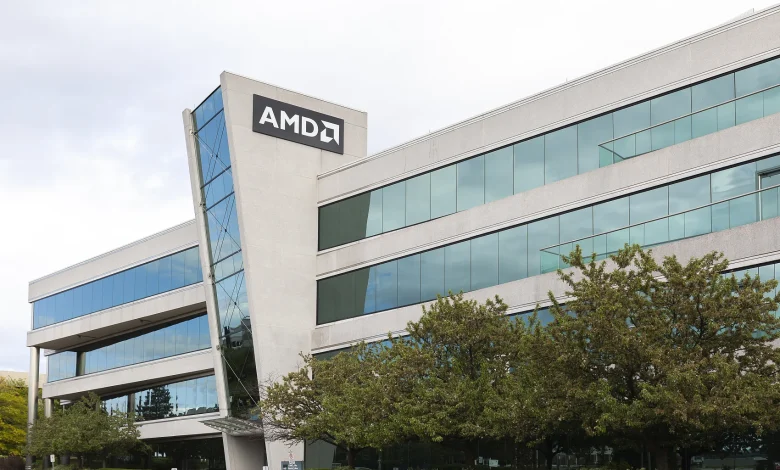U.S. stock bull market confidence in crisis, urgently needs AMD (AMD.US) earnings report to save the situation.

After experiencing its best month of stock performance in nearly 25 years, AMD needs to demonstrate that it is indeed a major beneficiary of the artificial intelligence (AI) spending boom. This demonstration will begin with the company’s earnings report released after the US stock market closes on Tuesday.
As the rally in U.S. stocks faces headwinds, $Advanced Micro Devices (AMD.US)$ Advanced Micro Devices (AMD) is set to release its earnings report after the market close on Tuesday. Following its best monthly stock performance in nearly 25 years, the AI giant needs to demonstrate that it is indeed a major beneficiary of the AI spending boom. This earnings report will either boost confidence in risk assets, which have already been under pressure, or further weigh down the market. Wall Street currently expects AMD’s third-quarter revenue to reach $8.75 billion, with earnings per share (EPS) at $1.17.
On Tuesday, the three major U.S. stock indexes performed weakly as another AI giant, Palantir, reported unsatisfactory earnings and Wall Street executives warned of overvalued equity markets. Meanwhile, the dollar rose to its highest level since August amid mixed signals from Federal Reserve officials regarding the interest rate path. U.S. Treasury prices rebounded, with the 10-year yield falling 1 basis point to 4.10%. Gold prices declined for a third consecutive trading day, while Bitcoin approached its lowest level since June.
Wall Street executives, including Ted Pick of Morgan Stanley and David Solomon of Goldman Sachs, speaking at a summit in Hong Kong, stated that markets could see a correction exceeding 10% within the next 12 to 24 months. While they noted that such a correction could be healthy, their cautious stance stems from concerns about elevated stock prices, following a more than 35% surge in the S&P 500 Index since its April lows, largely driven by frenzied gains in tech giants tied to the AI boom.
Market Focuses on AMD’s Forward Guidance Amid Elevated Valuation
AMD’s stock price soared 58% in October, marking its best single-month performance since January 2001 and making it the top performer in the S&P 500 Index last month. This rally was primarily driven by the company’s partnership agreement with OpenAI, a deal that could bring AMD tens of billions of dollars in new revenue. Boosted by this news, AMD shares surged nearly 24% on October 6.
The year 2025 will be extraordinary for AMD. Despite an 18% decline in 2024, the stock has risen 115% year-to-date, ranking eighth among the best-performing stocks in the S&P 500. It is also one of the leading gainers in the Philadelphia Semiconductor Index. AMD’s stock price growth has even outpaced its main rival NVIDIA (NVDA.US), which has risen over 54% so far this year.
In addition to its partnership with OpenAI, AMD has signed a series of AI chip sales agreements. With its forward price-to-earnings ratio now approaching 43 times — the highest level since April 2024 — investors are eager to hear the company’s latest outlook on its earnings prospects.
Neville Javeri, Portfolio Manager overseeing approximately USD 15 billion in assets and Head of the Empiric LT Equity team at Allspring Global Investments, stated: ‘AMD is on an unprecedented growth trajectory, allowing the market to overlook concerns about its high valuation.’
Although the collaboration with OpenAI is undoubtedly the focus of analysts’ attention, its tangible impact may still be difficult to discern in the financial data. Meanwhile, data shows that the consensus forecast for AMD’s third-quarter net profit has been revised downward by 1.2% over the past month.
As a result, AMD’s earnings outlook is particularly crucial. Wall Street generally bets on the company’s smooth execution, as evidenced by analysts’ successive upward revisions of its 2026 earnings and revenue forecasts. Over the past month, the consensus estimate for AMD’s revenue next year has increased by 4.6%, while the consensus forecast for net profit has surged by 12%.
Neville Javeri commented: ‘Even though AMD has performed exceptionally well this year, new risks remain concerning its ability to execute these deals. If results fall short of expectations, it could prove to be an expensive lesson.’
Maintaining strong stock price performance might not be easy. While AMD is gradually gaining market recognition as a formidable competitor to NVIDIA, the latter still firmly dominates the core AI chip market.
Moreover, AMD’s deal with OpenAI has heightened market concerns about the structure of AI funding cycles. Under the agreement terms, OpenAI can purchase up to 160 million shares of AMD at one cent per share upon reaching specific project milestones, equivalent to approximately 10% of outstanding shares.
AMD’s high valuation implies that its stock price could come under pressure if future growth fails to meet analysts’ expectations. Currently, its price-to-earnings (P/E) ratio is significantly higher than its five-year average (approximately 32 times) and notably exceeds that of NVIDIA. Despite projected slower revenue growth for AMD—28% this year and 27% next year—it lags behind NVIDIA, which is expected to grow at approximately 56% annually over the same period.
AMD closed at USD 259.65 on Monday, surpassing the analysts’ average target price by more than 5%, indicating that the market widely believes the stock has limited upside potential. Technically, the 14-day Relative Strength Index (RSI) stands at 69.8, nearing the overbought threshold.
Capex from tech giants supports AI sector momentum
However, against the backdrop of continued AI investment by tech giants, AMD’s stock price may still find support. Data indicates that Alphabet (GOOGL.US), Meta (META.US), Amazon (AMZN.US), and Microsoft (MSFT.US) collectively spent over USD 110 billion on capital expenditures last quarter, with total spending projected to increase by 34% year-over-year in the next 12 months, reaching approximately USD 440 billion.
Supply chain data shows that approximately 13% of AMD’s revenue comes from these four companies. Some analyses have pointed out that this capital expenditure ‘enhances the visibility of AI chip manufacturers’ and stated, ‘This increase in spending will support the performance of AI chip suppliers (such as NVIDIA, AMD, Broadcom, and Astera Labs) in the second half of the year, while mitigating the risk associated with hyperscale cloud vendors’ budget digestion.’
Timothy Ghriskey, Senior Portfolio Strategist at Ingalls & Snyder, stated that large-scale capital expenditures will continue to support AI-related trading. He remarked, ‘The amount of funding poured into the market by major technology companies is substantial, and there is enough ‘pie’ to share. Indeed, there are some stocks with lower valuations, but the real story lies in the astonishing growth of AI and technology. This trend is far from over. Yes, NVIDIA is the market leader, but more and more people are realizing that AMD is performing equally well.’
As a structured product with fixed dividends, FCN offers the following advantages:
1. Stable monthly dividend: Receive agreed coupon payments monthly during the holding period, ensuring stable and predictable cash flow.
2. Downside protection: As long as the price does not fall below the safety line at maturity, investors can recover 100% of the principal even if the stock price declines.
3. Flexible underlying stocks: Investors can choose single or multiple stocks (underlying assets), making it easier to align with different risk preferences and investment objectives.
Click to view FCN products >
Editor/Lambor





